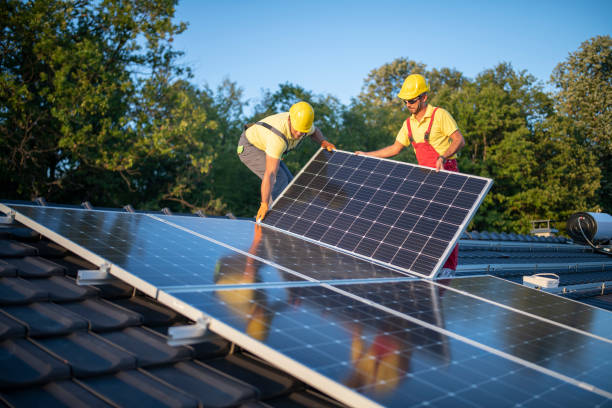The first step in your solar installation plan is to evaluate your property’s solar potential. Factors such as location, roof condition, orientation, and shading play a crucial role in determining the efficiency and size of your solar array. An assessment by a professional can provide a roadmap tailored to your specific energy needs and goals.
Choosing the Right Solar Panels Efficiency Matters
The efficiency of a solar panel is a measure of its ability to convert sunlight into electricity. Higher efficiency means more electricity generation from a smaller area, making efficient panels particularly valuable for roofs with limited space. Monocrystalline panels tend to have higher efficiency rates compared to polycrystalline panels because they are made from a single, pure crystal structure, allowing for better electron flow.
Cost vs. Long-Term Gains
While polycrystalline panels may come at a lower upfront cost, it’s important to consider the long-term energy production and savings that more efficient monocrystalline panels can provide. This is particularly true in regions with high electricity rates, where the return on investment could justify the higher initial expenditure.
Warranty and Lifespan
The warranty a manufacturer offers can serve as a confidence indicator in the longevity and performance of your solar panels. Look for warranties that cover a significant time frame – typically between 20 to 25 years. A robust warranty not only ensures peace of mind but also signals that the manufacturer stands behind their product’s durability.
Assessing the Manufacturer’s Reputation
Researching the manufacturer can offer insights into the panel’s performance over its lifetime. Look for companies with a track record of stability, customer satisfaction, and a history of honoring their warranties. Panels from reputable manufacturers may cost more, but the investment can be worthwhile for their reliability and service.
Considering Aesthetic Impact
Solar panels are a visible addition to your home, and their appearance can be a concern for some homeowners. Monocrystalline panels’ sleek, dark look is often preferred for its ability to blend better with the roof, whereas polycrystalline panels’ blue hue and speckled appearance might be less visually appealing.
Future Expansion Possibilities
Your energy needs may increase over time, so it’s prudent to consider whether you may want to expand your solar array in the future. Some solar panels and systems are more adaptable and easier to expand than others. Ensure your initial choice of panels can integrate smoothly with additional panels if needed.
Local Climate and Conditions
Not all panels perform equally across different environments. For instance, some panels are designed to perform better in high temperatures without efficiency losses. Others might be better suited to withstand heavy snow loads. Your local climate should directly influence the type of panels you choose.
Compatibility with Your Roof
Solar panels are not a one-size-fits-all solution – they need to complement your roof’s size, shape, and weight-bearing capacity. Professional installers can advise on the best system layout and panel orientation to maximize energy production while ensuring structural integrity.
By taking these factors into careful consideration, you can select the solar panels that best match your specific circumstances. An informed decision helps to ensure that your solar installation is not only optimized for maximum energy production but also aligns with your financial goals and aesthetic preferences. Remember, the right panels are a cornerstone of a successful solar energy system, poised to provide clean energy and savings for many years.
Understanding Solar Inverters
The inverter is the heart of your solar installation, responsible for converting direct current (DC) generated by your panels into alternating current (AC) used by your home’s electrical system. There are various inverter options available, such as string inverters, microinverters, and power optimizers. Each has its use case, and the right choice can greatly affect your system’s performance.
Also Read=How has glazing technology improved over the last decade?
Navigating Permits and Paperwork Securing the Necessary Approvals
Before installing a solar power system, you must obtain specific permissions from local authorities. This typically includes building permits and interconnection agreements with your utility company. Understanding the requirements and processes in your area can ensure compliance and avoid delays.
The Importance of Rebates and Incentives
Solar installations often qualify for rebates, tax credits, and incentives that can substantially reduce the overall cost. It’s essential to research and apply for these benefits, as they can make the transition to solar more financially accessible.
Installation Day and Beyond Preparing for Solar Panel Installation
Preparation is key to a smooth installation day. Clear the area around your home, and ensure the installation crew has easy access to your roof. Professional installers will then safely and efficiently install the racking, panels, and inverter to get your system up and running.
Monitoring and Maintenance
After installation, ongoing monitoring is vital to ensure your system performs optimally. Most modern solar systems are equipped with monitoring software that provides real-time data on energy production. While solar panels require minimal maintenance, periodic cleanings, and inspections can prolong the life of your installation.
Solar installation offers a pathway to energy independence and environmental stewardship but navigating this pathway requires understanding the steps involved in the process. By recognizing the importance of site assessment, selecting the correct equipment, dealing with permits, and understanding the financial implications, homeowners can confidently embrace solar energy. While the journey from panels to power involves several steps, the result is a robust system that can provide clean, renewable energy for years to come, making the effort well worth it.

James Oliver is a professional blogger and a seasoned Content writer for technologyspell.com. With a passion for simplifying technology and digital topics, he provides valuable insights to a diverse online audience. With four years of experience, James has polished his skills as a professional blogger.




